Whether you’re looking at mast lighting, linear systems, or a blend of both, every design choice impacts not only game performance but also broadcast quality and safety. Dive into the world of rugby field lighting and discover how thoughtful design and meticulous maintenance can illuminate every match with clarity and precision!
Rugby has long been a sport known for its high intensity, physicality, and passionate fan base. Whether played at a community club or in a professional stadium, the experience of the game relies not only on the skill of the players but also on the quality of the environment. Lighting plays a significant role in this, especially for matches held in the evening or under overcast skies. Proper rugby field lighting ensures that players perform at their best and spectators enjoy a clear, immersive view of the action. From lux levels to lighting systems, design layouts to operational costs, every aspect of rugby field lighting demands thoughtful consideration.
Reach out for free lighting consultation
Table of Contents
Toggle| Competition Level | Horizontal Lux Range | Vertical Lux Range | Notes |
|---|---|---|---|
| Training & Recreational Play | 75 – 200 lux | N/A | Suitable for casual matches with basic visibility needs |
| Club-Level Matches | 300 – 500 lux | N/A | Meets regional standards, supports local spectators and amateur leagues |
| Professional Matches (Non-TV) | 800 – 1200 lux | Up to 1400 lux | Higher brightness for fast play and clear ball tracking |
| Professional Matches (TV/Stream) | 800 – 1200 lux | Up to 1400 lux | Essential for broadcast quality with superior uniformity and motion clarity |
Lighting intensity, measured in lux, plays a crucial role in shaping the overall playing and viewing experience on a rugby field. The amount of light required varies depending on the level of competition and whether the match is being broadcast on television. For training grounds or recreational play, where the demands on visibility are less stringent, lux levels usually range between 75 and 200 lux. This level of illumination offers sufficient clarity for players to move safely and follow the ball during casual matches without the need for high-powered lighting systems, which can be costly and energy-intensive.
When it comes to club-level matches, particularly those with local spectators and amateur league participants, the lighting needs to step up. These games usually require around 300 to 500 lux. At this intensity, the lighting provides a reliable, consistent environment that meets most regional guidelines and offers an improved experience for both players and fans. This range allows the ball’s movement to be tracked more easily and reduces eye strain during evening matches, without the complexity of broadcast-level lighting.
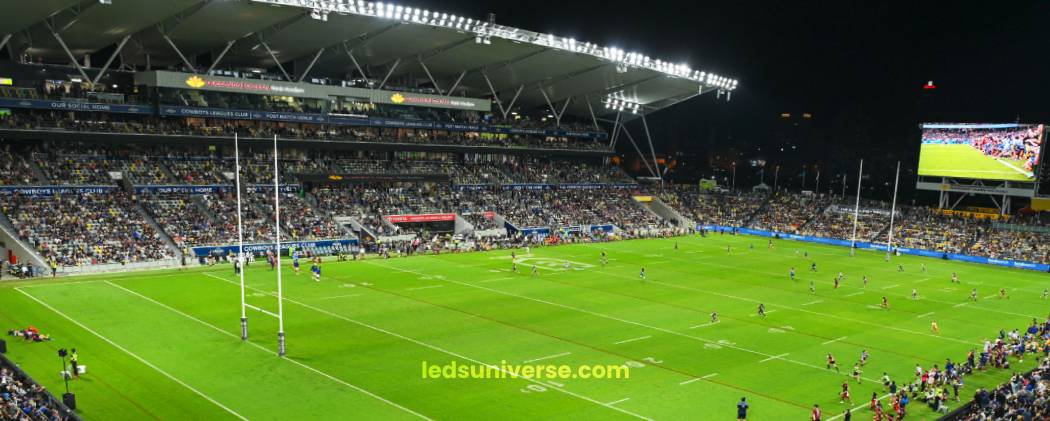
For professional rugby games and stadiums that host national or international competitions, the requirements become considerably more demanding. Matches that are televised or streamed live need much higher illumination to capture every detail from multiple camera angles. Horizontal illuminance is typically set between 800 and 1200 lux, providing the brightness needed for fast-paced play and high-speed ball tracking. Additionally, vertical illuminance—measuring the light hitting players and objects from a viewer or camera perspective—can reach up to 1400 lux in some areas of the field. This vertical lighting is especially vital for broadcasters to capture clear and vibrant images without motion blur or flickering. By achieving these levels, the lighting supports both the athletes’ performance and the audience’s ability to follow the game seamlessly.
Beyond simply having enough light, the evenness or uniformity of lighting across the rugby pitch is equally significant. Uneven lighting can create problematic areas, where shadows or overly bright spots disrupt the flow of play and affect both players’ vision and camera clarity. If parts of the field are poorly lit or have glaringly bright sections, it becomes harder for players to judge distances and ball trajectories accurately, which can influence the outcome of a game.
A well-designed rugby field lighting system aims for a uniformity ratio—the relationship between the minimum and average lux levels—of at least 0.6. This means the darkest parts of the field should not fall below 60% of the average illumination level. For stadiums catering to professional matches and TV broadcasts, this ratio climbs closer to 0.7 or higher, providing a consistently balanced light environment. Achieving this level of consistency is a challenge, given the size of a rugby field and the different angles from which light must be cast. It demands careful positioning and angling of the floodlights, often requiring a mix of different luminaire types and precise aiming. Lighting designers work to avoid shadows created by goalposts, players, or other obstacles, ensuring that every corner of the field is equally visible.
The color temperature of rugby field lighting significantly affects how the game looks to players, spectators, and broadcast cameras. This aspect defines the “warmth” or “coolness” of the light, measured in Kelvin (K). For local games and training facilities, a neutral white light with a color temperature between 4000K and 5000K is commonly used. This range offers a natural daylight feel, reducing eye fatigue while allowing colors to appear realistic and consistent. It also supports good visibility during late afternoon or early evening sessions without overwhelming the environment with harsh light.
In contrast, stadiums that regularly host professional matches, particularly those broadcast to wider audiences, favor cooler color temperatures, often above 5600K. These cooler tones mimic natural daylight more closely, which enhances the clarity and sharpness of images captured by television cameras. The higher color temperature also helps players differentiate colors on the field more easily, whether it’s the contrasting uniforms of the teams, the ball, or boundary markings. Choosing the right color temperature contributes to a vivid viewing experience and ensures that the details of the game come through clearly on every screen, from stadium displays to high-definition broadcasts.
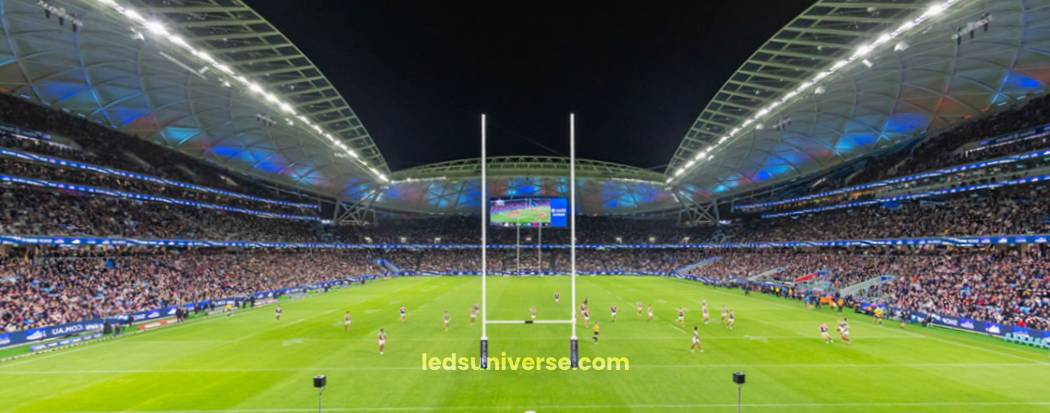
Glare presents one of the more challenging issues in rugby field lighting design. It occurs when light shines directly into the eyes of players or spectators, causing discomfort and reducing the ability to see clearly. This can be particularly disruptive in rugby during moments when players need to look upward for high balls during lineouts or kicks. Excessive glare may slow reaction times or even lead to safety concerns as players momentarily lose sight of the ball or other players.
To measure and control glare, designers use a scale called the Glare Rating (GR). A lower GR indicates less visual discomfort. For professional rugby venues, a GR rating of below 50 is generally the target. Achieving this involves using lighting fixtures with asymmetric beams that direct light specifically onto the playing area without spilling into the eyes of players or fans. Other solutions include anti-glare visors attached to floodlights and carefully calculated mounting angles to minimize direct light intrusion.
By balancing the need for bright, even illumination with effective glare control, stadium lighting can create a visually comfortable environment that allows everyone involved—from players to spectators—to stay focused on the game.
| Lighting Layout | Description | Advantages | Considerations |
|---|---|---|---|
| Roof-Mounted Lighting | Fixtures installed on the stadium roof, offering precise downward angles and sleek design. | Minimizes light spill and shadows; preserves sightlines; easier maintenance | Best for enclosed or partially covered stadiums; may require integration with side lighting |
| Four-Pole Layout | Four poles placed at corners or near field edges, angled inward to cover the pitch. | Cost-effective; simple installation | Requires powerful floodlights; may cause uneven lighting and shadows in center field |
| Six-Pole Layout | Six poles spaced more evenly around the field, common in semi-professional or municipal venues. | Improves uniformity and reduces shadows; balanced cost-performance | Moderate installation complexity; better lighting quality than four-pole setups |
| Eight-Pole Layout | Eight poles surrounding the field, typical in professional stadiums and broadcast venues. | Superior light control; high uniformity; lower wattage fixtures; reduced glare | Higher upfront costs; complex installation; enables dynamic lighting and zoning |
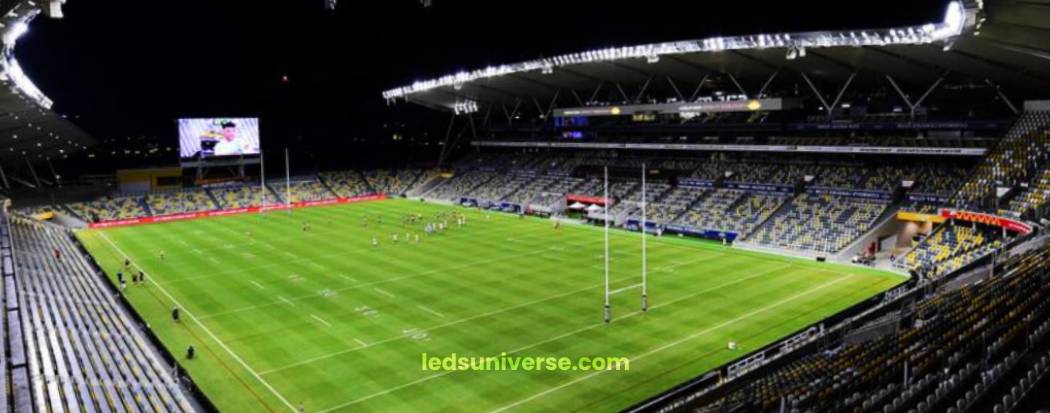
In enclosed rugby stadiums, roof-mounted lighting offers an effective and elegant solution. Fixtures are installed directly on the roof structure, which allows for highly precise downward angles of light. This placement helps illuminate the field evenly without obstructing spectators’ views or creating bulky light towers around the playing area. Roof-mounted lights are often combined with side-mounted fixtures to meet both vertical and horizontal lighting requirements, ensuring that cameras and fans have clear sightlines from multiple angles.
One of the advantages of roof-mounted lighting is its ability to minimize light spill and unwanted shadows. Since the lights are integrated into the stadium’s architecture, they avoid interference from structural elements that could otherwise block or scatter light unevenly. This makes roof lighting particularly suited for modern stadiums aiming for a sleek look without sacrificing performance. Additionally, this setup can simplify maintenance and reduce installation costs compared to tall external poles, especially in fully enclosed or partially covered venues.
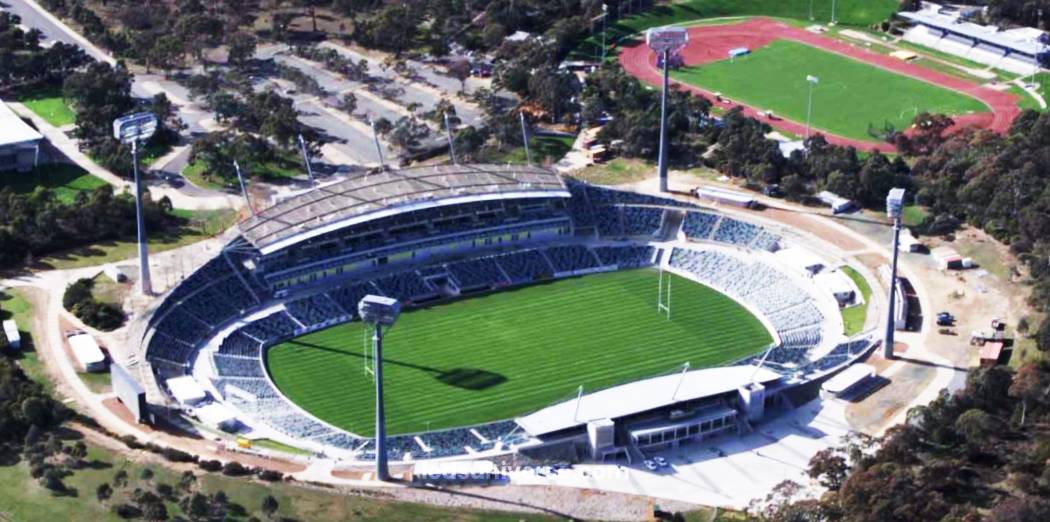
The four-pole layout remains one of the most widely used lighting configurations, especially for community rugby fields, schools, and regional clubs. In this setup, poles are strategically placed at the four corners or just outside the playing area, angled inward to cover the entire field. The simplicity of this design makes it relatively affordable and straightforward to install, which suits facilities working within tighter budgets.
However, the distance between the poles and the center of the field means floodlights often need to be more powerful to achieve the required lux levels, especially in the middle of the pitch. This can sometimes result in uneven light distribution, with potential shadowing and hotspots if the system is not carefully designed. Despite these challenges, a well-executed four-pole layout can provide adequate lighting for training sessions and non-broadcast matches, making it a practical choice for many local rugby venues.
Adding more poles generally improves the quality of lighting by increasing uniformity and reducing shadowing. A six-pole layout is commonly found in semi-professional or municipal fields where the goal is to balance cost with enhanced lighting performance. By spacing the poles more evenly around the field, this arrangement allows floodlights to be positioned closer to the playing surface, reducing the need for extreme beam angles. The result is a more consistent and balanced illumination, which benefits both players and spectators.
For larger or professional venues, an eight-pole system is often preferred. This configuration provides superior control over the direction and spread of light, making it easier to maintain the high lux levels and uniformity required for televised matches and national competitions. With more poles surrounding the field, lighting designers can use lower wattage fixtures while achieving better coverage and minimizing glare. The closer pole spacing in eight-pole layouts also reduces the chance of deep shadows and bright hotspots, ensuring a smooth, continuous light across the entire playing area.
These multi-pole configurations demand a more complex installation and higher upfront costs but provide significant advantages in terms of performance and flexibility. For stadiums hosting a range of events, from rugby to concerts or other sports, the additional poles enable the use of dynamic lighting controls and zoning, further enhancing the venue’s versatility.
Mast lighting is the most traditional and widely used approach for outdoor rugby fields around the world. This system relies on tall steel poles or lattice towers that hold multiple floodlights, typically positioned high above the playing surface to maximize coverage. The height and placement of these masts depend on the size of the field and the required illumination levels, ensuring that the entire pitch receives consistent light.
Historically, these floodlights were metal halide lamps, but there has been a significant shift toward modern LED floodlights. LED technology offers several advantages: it provides greater directional control, allowing light to be focused precisely where it’s needed, while also reducing energy consumption and operational costs. Mast lighting systems are adaptable to various layout designs, from four-pole to eight-pole configurations, making them a versatile choice for many clubs and stadiums. This flexibility allows designers to balance performance, cost, and aesthetics based on the venue’s specific needs.
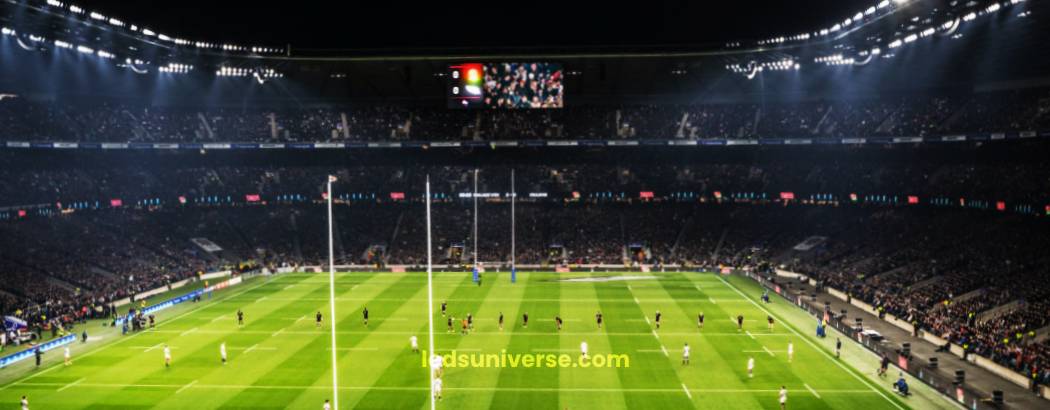
In contrast to mast lighting, linear lighting systems represent a more contemporary solution, often favored in enclosed or architecturally sensitive venues. Instead of relying on point sources of light mounted on poles, linear lighting uses continuous or segmented LED fixtures arranged in straight lines. These fixtures can be integrated into the stadium’s roof structure or along walls, blending seamlessly with the architectural design.
One of the main benefits of linear lighting is its ability to create uniform illumination without the mid-field shadows that can sometimes occur with traditional floodlights. Because the light source is spread over a longer area, the coverage is more consistent, reducing sharp contrasts and dark spots on the playing surface. This type of system is particularly effective in stadiums where the visual experience matters greatly for both spectators and television audiences, as it supports smooth and balanced lighting across the entire field.
Some modern rugby stadiums opt for a hybrid or mixed lighting approach, combining the strengths of different systems to meet a range of requirements. For example, a venue might use traditional mast lighting for the primary illumination but supplement it with roof-mounted or linear fixtures to improve vertical lighting or to control glare and shadows more precisely.
Mixed lighting systems are especially valuable in multi-use venues that host a variety of events beyond rugby, such as concerts, other sports, or community gatherings. This flexibility allows operators to tailor the lighting setup dynamically, adjusting brightness levels or focusing on specific areas as needed. Features like dimming zones, spotlighting, or color temperature shifts can be integrated into the system, creating immersive environments for ceremonies or special events. By combining different lighting technologies, stadiums can optimize performance while adapting to diverse operational demands.
| Cost Category | Typical Range / Example | Notes |
|---|---|---|
| Floodlight Unit Price | Entry-level: $300 – $800 Match-grade: $1,000 – $3,000 Stadium-grade: $5,000+ | Depends on lighting quality, optics, wattage, and broadcast certification |
| Number of Fixtures | Small club field: 20 – 30 Professional stadium: 60 – 100 | Varies with layout, field size, and required lux levels |
| Installation Costs | Four-pole system: $30,000 – $70,000 Complex systems: $150,000+ | Includes labor, electrical wiring, pole foundations, mounting, and safety installations |
| Running Costs | Approx. $7.20 per 2-hour session (30 fixtures @ 1000W) Annual: $2,000 – $6,000 (club-level) | Energy consumption depends on fixture wattage and usage frequency |
| Maintenance Costs | 1% – 2% of initial installation cost annually | Includes cleaning, inspections, occasional replacements, and access equipment expenses |
The price of floodlights can vary significantly based on the level of lighting performance required for the rugby field. For entry-level LED floodlights, suitable primarily for training or recreational fields, the cost per unit generally falls between $300 and $800. These fixtures provide adequate illumination for basic visibility but are not designed to meet the rigorous standards of competitive play.
When moving into competitive match-grade lighting, the price range increases substantially. Fixtures designed to meet the higher lux levels and uniformity standards of league or semi-professional matches typically cost between $1,000 and $3,000 per unit. For professional stadiums hosting televised or national competitions, stadium-grade floodlights can exceed $5,000 each, reflecting their advanced optics, superior light output, and enhanced control features.
The total number of floodlights needed for a full-size rugby pitch depends on the lighting layout and required brightness levels. A small club field with a four-pole setup might need around 20 to 30 fixtures, while larger stadiums with six- or eight-pole configurations may require between 60 and 100 floodlights to ensure consistent illumination throughout the field.

Beyond the cost of the lights themselves, installation represents a significant portion of the budget. This includes the labor required for electrical wiring, pole erection, mounting hardware, and integrating the lighting control systems. For a standard four-pole LED lighting system aimed at moderate lux levels, installation expenses typically range between $30,000 and $70,000.
More complex setups, such as an eight-pole array or a roof-mounted lighting system within an enclosed stadium, involve additional costs that can push the installation price above $150,000. Factors that influence these costs include the need for underground electrical cabling, reinforced concrete footings to secure tall poles, and safety features such as lightning protection systems. Each of these elements adds to the overall expense but contributes to the longevity and reliability of the lighting infrastructure.
One of the advantages of LED floodlights over older metal halide or halogen systems is their significantly lower energy consumption. To put this into perspective, a rugby field operating 30 LED fixtures at 1000 watts each will draw approximately 30 kilowatts per hour. At an average electricity cost of $0.12 per kilowatt-hour, a two-hour evening session would cost roughly $7.20 in energy use.
Annual running costs will depend heavily on how often the field is used under floodlights. For club-level fields with moderate usage, yearly electricity expenses might range from $2,000 to $6,000. Professional stadiums, which host frequent matches and events, naturally incur higher operating costs, sometimes several times this amount. Despite this, LED technology remains the more economical choice for long-term use due to its superior energy efficiency.
LED floodlights are known for their long lifespans, often lasting between 50,000 and 100,000 hours before needing replacement. This longevity means maintenance costs tend to be lower compared to older lighting technologies. However, regular maintenance remains necessary to keep the lighting system operating at peak performance. This includes periodic cleaning of lenses and fixtures, routine inspections for electrical safety, and eventual replacement of any malfunctioning units.
Maintenance budgets for rugby field lighting typically allocate around 1% to 2% of the initial installation cost annually. Mast lighting systems, in particular, may require additional expenditures for access equipment such as cherry pickers or cranes to reach high-mounted fixtures safely. These service requirements should be factored into long-term financial planning to avoid unexpected expenses and ensure consistent light quality over the years.
Selecting an appropriate lighting system begins with a clear understanding of how the rugby field will be used. For local clubs, schools, or community venues where matches and training sessions happen less frequently, cost-efficiency and ease of maintenance tend to take priority. In these cases, a four-pole LED mast system often provides a practical balance of affordability and sufficient lighting performance.
Conversely, venues hosting professional or televised matches must comply with more rigorous standards. These facilities require lighting designs that deliver high uniformity, excellent color rendering, and minimal glare to ensure player safety and high-quality broadcast images. Advanced control systems that allow precise management of light levels and zones also become a necessity.
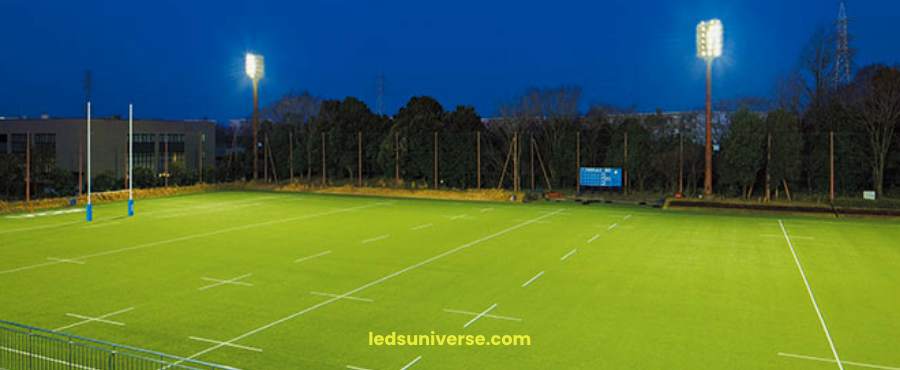
The physical characteristics of the stadium or playing field heavily influence the choice of lighting technology. Enclosed stadiums or arenas typically benefit from linear or roof-mounted lighting systems. These integrate smoothly with the architecture, reducing the visual clutter of large poles and improving shadow control. They also minimize light spillage outside the stadium, which can be important in urban or environmentally sensitive areas.
Open rugby fields require tall mast lighting to provide the broad, even illumination necessary across the large playing surface. Proper pole placement and height are crucial to avoid dark spots or glare that could interfere with player vision. A well-executed layout ensures the lighting complements the natural surroundings without causing excessive disturbance.
Lighting plays a significant role beyond basic visibility; it shapes the entire atmosphere of the game. Thoughtfully designed lighting improves crowd visibility, helping fans follow the fast-paced action from the stands and enhancing their overall experience. For broadcasters, effective lighting is essential for capturing clear, vibrant images, with accurate colors and minimal motion blur.
For players, well-designed lighting minimizes visual strain and glare, enabling better focus and safer play—especially during high kicks or lineouts when tracking the ball against a bright sky or stadium backdrop can be challenging.
Recent advancements in LED technology have opened new possibilities for rugby field lighting. Modern systems support adaptive lighting schemes that adjust brightness based on game intensity, time of day, or weather conditions. Features such as dimming zones, energy monitoring, and smart controls allow stadium operators to optimize energy consumption and reduce environmental impact.
By integrating these smart controls, venues can schedule lighting usage to match event needs precisely, avoiding wasteful over-illumination. This flexibility not only lowers operating costs but also aligns with growing expectations around sustainability in sports facilities.
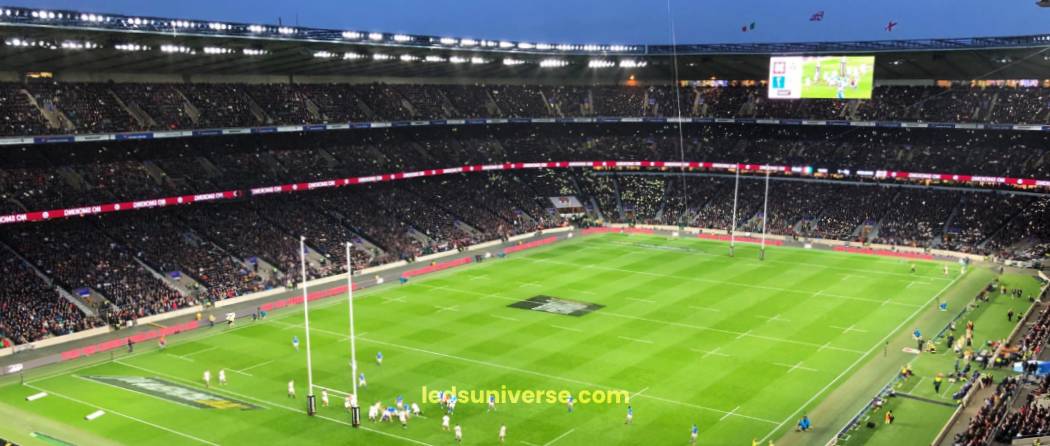
Twickenham Stadium, famously known as the home of English rugby, is one of the largest dedicated rugby venues in the world with a seating capacity exceeding 82,000. Over the years, its lighting system has undergone multiple upgrades to keep pace with modern broadcasting standards and the expectations of live spectators. The stadium now utilizes a sophisticated combination of high-power LED mast lighting along with roof-mounted fixtures carefully positioned to optimize both horizontal and vertical illuminance.
For televised matches, the lighting system is capable of delivering lux levels exceeding 1200, ensuring that cameras capture clear, vibrant images without shadows or glare. Uniformity across the playing surface is meticulously maintained, so there are no dark spots that could affect player visibility or camera footage. Color rendering is also a priority, with lights designed to render colors naturally and vividly, enhancing the viewing experience both in the stadium and on television screens around the world.
Twickenham has integrated advanced lighting control systems that enable dynamic adjustments during events. These systems allow lighting scenes to change for player entrances, celebrations, or halftime shows, adding a layer of spectacle to the rugby experience. The control technology also facilitates energy-efficient operation by dimming or switching off certain zones when not in use, aligning with sustainability goals.

Eden Park holds a special place in rugby history as New Zealand’s premier venue, known globally for hosting major events including Rugby World Cup finals and All Blacks matches. Its lighting system exemplifies a mixed approach, combining traditional and contemporary technologies to meet both the functional and aesthetic needs of a world-class stadium.
The stadium is equipped with tall LED masts positioned strategically around the perimeter of the field, providing the powerful, broad-spectrum illumination required for night games and international broadcasts. Complementing these are roof-mounted linear LED fixtures, which are seamlessly integrated into the stadium’s architectural design. This combination minimizes shadows and glare, providing consistent lighting that enhances player performance and spectator enjoyment.
Eden Park’s recent lighting upgrades have placed a strong emphasis on energy efficiency and minimizing the impact on nearby neighborhoods. The lighting design includes shielding and directional control to reduce light spill, addressing concerns about light pollution in the surrounding residential areas. This balance between high-performance lighting and environmental responsibility highlights Eden Park’s commitment to sustainable stadium operations while maintaining world-class standards.
As France’s national stadium, Stade de France hosts a variety of major sporting events, including high-profile rugby matches that draw international attention. The stadium’s lighting system is engineered to accommodate a wide range of activities, requiring flexibility alongside top-tier illumination.
The system primarily consists of an eight-pole mast configuration outfitted with cutting-edge LED floodlights that deliver lux levels well over 1500 during major rugby fixtures. This intense illumination ensures excellent visibility for players and spectators alike, while meeting the stringent requirements for high-definition television broadcasts. The stadium uses lighting fixtures with precise beam control and anti-glare technology, carefully designed to avoid discomfort for players and fans.
In addition to the powerful lighting hardware, Stade de France incorporates smart lighting controls that allow rapid changes to lighting scenes and intensities. This adaptability is crucial for a multi-use venue that hosts concerts, athletics events, and other sports, alongside rugby. The system supports quick transitions between events, optimizing the fan experience while maintaining operational efficiency.
Glare management and uniformity have been meticulously engineered at Stade de France to provide a consistently well-lit playing surface. This contributes not only to enhanced player safety but also to the clarity and sharpness of broadcast images. The stadium’s approach to lighting exemplifies how modern technology and thoughtful design can come together to support the needs of both athletes and audiences at the highest level of rugby competition.
The number of floodlights required for a rugby field depends on the field size, lighting layout, and desired lux levels. For a standard full-size rugby pitch, installations usually include between 20 and 100 floodlights, depending on the level of play and lighting quality needed. Smaller venues like club or training grounds often use fewer fixtures, typically around 20 to 40 units, as their lighting needs are less demanding.
In contrast, professional stadiums hosting high-profile or televised matches require 60 or more floodlights to ensure uniform illumination and meet strict lighting standards for player safety and broadcast clarity. The choice of floodlight type, such as high-efficiency LEDs with focused beams, also affects how many fixtures are necessary to avoid dark spots and maintain consistent lighting across the field.

Wattage requirements for rugby field floodlights vary depending on the type of fixture and the specific lighting objectives for the venue. Modern LED floodlights typically range from around 400 watts to 2000 watts per unit, offering a wide spectrum of power options to suit different needs.
For amateur or community fields, lower wattages—usually between 400 and 800 watts—are sufficient to provide adequate visibility for training and recreational matches. In contrast, professional stadiums and venues hosting high-level competitions generally rely on more powerful fixtures, often in the 1000 to 2000 watt range, to achieve the intense brightness and uniformity required for players, officials, and broadcast cameras.
LEDs are favored over older technologies like metal halide because they deliver much higher luminous efficacy, meaning they produce more light per watt of energy consumed. This results in better illumination with lower operating costs and a reduced environmental impact.
The price per floodlight varies significantly depending on the quality and performance of the fixture. For local rugby fields or community-level installations, entry-level LED floodlights typically cost between $300 and $800 per unit. These fixtures provide adequate lighting for training and amateur matches without the advanced features required for broadcast.
On the other hand, professional-grade floodlights designed for stadiums and high-profile events can range from $1000 to $5000 or more per fixture. The total investment depends heavily on the number of fixtures installed and their technical specifications, including factors like beam angle, wattage, and certification for broadcast use. Higher-end units often incorporate features to improve uniformity, glare control, and energy efficiency, justifying their premium price.
Lighting control systems manage the on/off switching, dimming, and scene-setting for rugby field lighting. These systems enable operators to tailor lighting conditions according to different needs, such as training sessions, match play, or special events.
Most modern rugby field installations use digital control systems based on DMX or DALI protocols. These technologies allow for precise and flexible adjustment of brightness levels, as well as the creation of dynamic lighting effects. Operators can also set lighting schedules remotely, improving convenience and operational efficiency.
Advanced lighting controls contribute to energy savings by dimming fixtures when full illumination is unnecessary, reducing overall power consumption. They also allow for event-specific lighting scenes, enhancing the atmosphere for spectators and providing customized lighting environments for different types of occasions.

LED floodlights commonly have lifespans ranging from 50,000 to 100,000 hours, depending on the quality of the fixture and usage conditions. This extended operational life means that under typical usage patterns, these fixtures can last several years without the need for replacement.
In contrast, older technologies such as metal halide floodlights have significantly shorter lifespans, usually around 15,000 to 20,000 hours. This shorter service life results in more frequent maintenance and replacement, increasing long-term costs and downtime for rugby field lighting systems.
The four-pole layout is the most common configuration for community and club rugby fields. Its popularity stems from its cost efficiency and simpler installation process, making it an accessible option for smaller venues with modest lighting requirements.
For semi-professional venues, a six-pole layout is often preferred as it offers a good balance between lighting quality and budget considerations. This setup improves uniformity and reduces shadows compared to the four-pole system, enhancing the playing experience.
At the highest level, professional stadiums typically use eight or more poles, often combined with roof-mounted fixtures. This comprehensive approach helps achieve optimal uniformity and glare control, meeting the stringent demands of high-intensity competition and broadcast standards to ensure the best possible visibility for players, officials, and viewers alike.
Yes, many modern rugby venues integrate field lighting with other lighting systems, including stadium lighting, emergency lighting, and architectural lighting. This integration creates a cohesive lighting environment that serves multiple purposes beyond just illuminating the playing surface.
Such setups are especially common in multi-use arenas where flexibility is crucial. These venues often host concerts, other sports, and ceremonies, requiring lighting systems that can quickly adapt to different event types and atmospheres.
Integration is usually managed through centralized digital control systems. These systems allow for seamless coordination of lighting scenes and schedules, ensuring that each aspect of the venue’s lighting functions harmoniously while maximizing energy efficiency and operational convenience.
Energy use for rugby field lighting depends primarily on the number of floodlights, their individual wattage, and the duration of operation. For instance, a typical setup with 30 LED floodlights, each rated at 1000 watts, would consume about 30 kilowatts per hour when all fixtures are running at full power.
If the field is used for a standard two-hour event, the total energy consumption for that session would be approximately 60 kilowatt-hours (kWh). Over a season, this can add up significantly depending on the frequency of matches and training sessions.
Using energy-efficient LED technology combined with smart lighting controls can greatly reduce this consumption. Compared to older lighting systems like metal halide, LEDs provide more light output per watt and allow for dimming and scheduling, which further optimize energy use and lower operating costs.
Installation of rugby field lighting involves several critical steps, starting with foundation work for the lighting poles to ensure they are securely anchored. This is followed by trenching for electrical cabling, which connects the fixtures to power sources and control systems.
Next, the mounting of fixtures takes place at carefully calculated heights and angles to achieve the desired lighting uniformity and minimize glare. Proper alignment is key to delivering optimal illumination across the entire playing surface.
During installation, safety considerations are paramount. This includes strict adherence to local electrical codes, as well as structural standards for wind loading and stability to withstand environmental conditions.
Planning for maintenance access and future upgrades is also integrated into the installation process. This foresight helps ensure that ongoing upkeep is manageable and that the system can evolve with changing technology or increased lighting requirements over time.
Rugby field lighting is more than just a technical requirement—it shapes how the sport is experienced by everyone involved. From player safety to broadcast clarity, lighting influences the game’s integrity and entertainment value. Whether outfitting a grassroots club or a national stadium, a well-executed lighting plan considers design parameters, system types, structural layouts, and long-term costs. Investing in thoughtful lighting design ensures that every match, from training sessions to televised showdowns, takes place under conditions that reflect the true spirit and intensity of rugby.
If you’re planning to upgrade or install lighting for your rugby field or stadium, don’t hesitate to reach out. We offer a free, professional lighting design service tailored to your venue’s unique needs, ensuring optimal visibility, energy efficiency, and compliance with all standards. Contact us today to get started on creating the perfect lighting solution for your rugby facility.